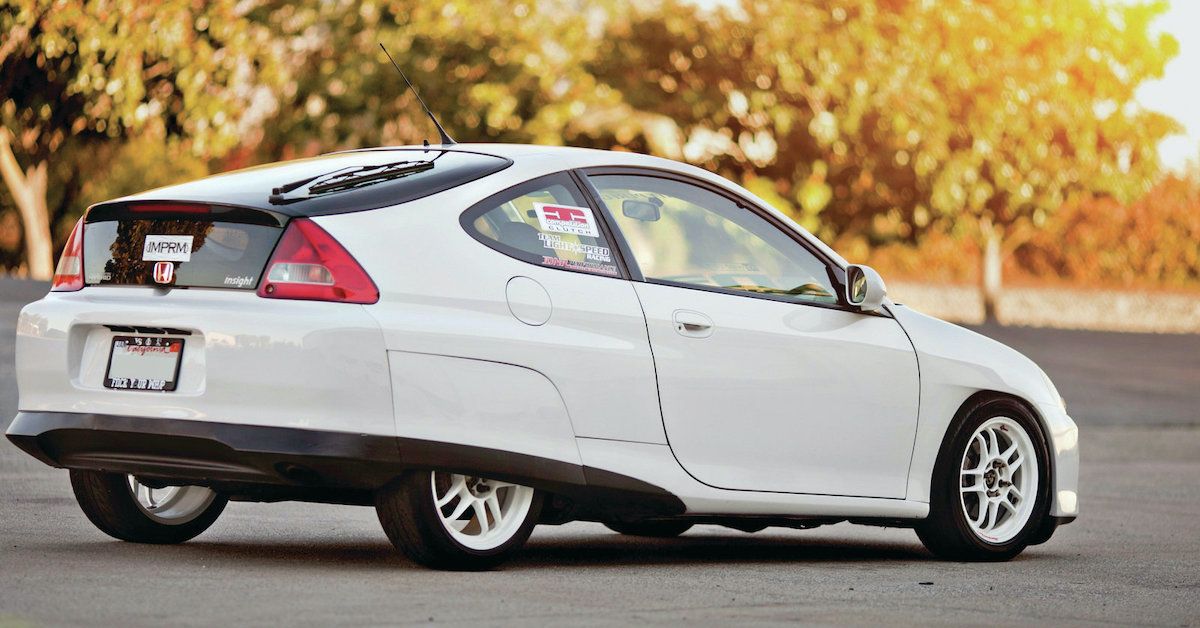Honda ushers in the new millennium by releasing the first production gasoline-electric hybrid to the public. The Insight can travel up to 70 miles per gallon of gas thanks to its ultra-low drag styling, aluminum body structure, and innovative Integrated Motor Assist (IMA) (With a 10.6-gallon gasoline tank, you can drive from Los Angeles to Salt Lake City and still have a gallon of gas left over). A new 1.0-liter three-cylinder engine and an ultra-thin electric motor help the gasoline engine accelerate. When the driver changes to neutral and releases the clutch pedal, the package contains an idle-stop mechanism that turns off the engine.
The Insight's 144-volt nickel-metal hydride batteries, unlike GM's all-electric EV-1, do not require an additional power supply to recharge. The majority of the system's electricity is generated by regenerative braking, and the Insight is stopped by ABS-assisted disc/drum brakes. The Insight accelerates quickly with a full charge and the electric motor providing full assistance, possibly faster than a Toyota Echo. The transmission, which is only available as a five-speed manual (built with unique gears to reduce rotational mass), has short first, second, and third ratios for good city driving performance and tall overdrive gearing in fourth and fifth to maximize fuel economy.
The unitized body of the Insight, like that of the Acura NSX, is made of aluminum (except for the front fenders, which are plastic) and has a drag coefficient of 0.25. Because of its aerodynamic bodywork, flat underbody, low rolling resistance tires, and extensive use of lightweight materials, the Insight requires 30% less power to operate at highway speeds than the Honda Civic. The effort to reduce weight drag, however, comes at a cost in terms of handling. The Insight is extremely vulnerable to crosswinds, and the narrow tires easily track any groove in the pavement, necessitating constant steering adjustments to compensate.
The 2000 Honda Insight's Cabin Offers Great Comfort
With a sweeping dash, aluminum trim surround, and high-tech LCD analog/digital instrument display, the interior of the '00 Honda Insight is just as futuristic. The cluster is divided into three sections: the left bank displays engine rpm, coolant temperature, and the engine's lights; the middle section displays a large digital speedometer, odometer, lifetime fuel economy bar graph, and instant fuel economy; and the right bank displays fuel level, battery level indicator, and the IMA charge and assist indicator.
Dual high-back bucket seats provide good lateral and lumbar support, and controls for power windows, mirrors, an AM/FM cassette stereo, ventilation, and optional automatic HVAC are all easily accessible. The Insight is an incredible value for a hybrid vehicle because it comes fully equipped (the only option is an automatic air conditioning system) with power windows, door locks, exterior mirrors, an AM/FM cassette stereo, dual airbags, a rear window defroster, and much more.
Despite its handling flaws and rapidly depleting batteries, Honda has finally created a realistic alternative to gasoline-only automobiles with an ultra-low-emission vehicle that can be driven anywhere without the need for an electrical outlet.
The Powertrain Of The 2000 Honda Insight
At its heart is a 1.0-liter three-cylinder VTEC-E gasoline engine with lean-burn technology, a low-friction design, and a slew of lightweight aluminum, magnesium, and plastic. A 144-volt nickel-metal hydride battery pack drives an ultra-thin (about 2.5 inches) DC-brushless motor, giving the 12-valve 67-horsepower engine an extra 13.4 horsepower and 25 pound-feet of torque. This unit functions as both a generator during deceleration and braking to recharge the vehicle's batteries (removing the need for an outside charge) and as the Insight's starter motor. All of this is kept in sync by a Power Control Unit.
Consider it a small electric turbocharger that activates on demand and, when combined with the only available five-speed manual transmission, propels the Insight from 0 to 60 mph in 10.5 seconds. It was more than enough to get through traffic on all types of roads during a follow-up encounter back in the Los Angeles home base.
Honda used its experience with the aluminum-bodied Acura NSX to develop a rigid, lightweight aluminum body for the Insight that is 40% lighter than a comparable steel unit while meeting all current global safety standards. The chassis and body panels are made of aluminum, and the front fenders and rear skirts are made of recyclable plastic. The entire package weighs only 1887 pounds. The Insight earned the EPA's highest mileage rating ever, with 61-mpg in the city and 70-mpg on the highway, thanks to an aerodynamic design that yields a dramatic 0.25 Cd.
Here Is The Cost Of The 2000 Honda Insight Today
This automobile is unlike any other on the road. The two-seat Honda Insight appears sleek and futuristic. It is, indeed. It is considered the most aerodynamic production car on the road, according to Honda. In 2000, the Honda Insight became the first gasoline-electric hybrid vehicle to be sold in the U.S.
There is only one model of the 2000 Honda Insight available, which costs $18,880. The price rises to $20,080 when the factory-installed automatic climate control is added.
The Insight provides the environmental advantages of an electric vehicle without the hassles. It drives like a regular small car, but it is the world's most fuel-efficient and cleanest gasoline-powered vehicle. Only a zero-emissions pure electric car emits tailpipe emissions. It's exactly the kind of thing that car enthusiasts and environmentalists should enjoy.
Sources: NewCarTestDrive, MotorTrend, Edmunds


.jpg)
.jpg)
.jpg)